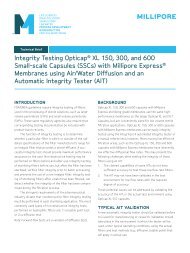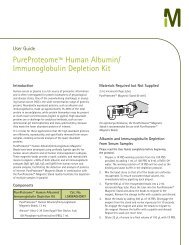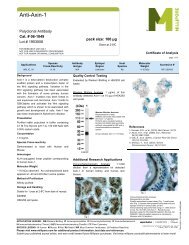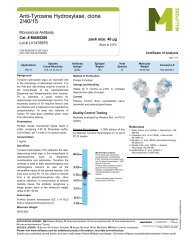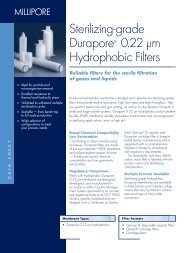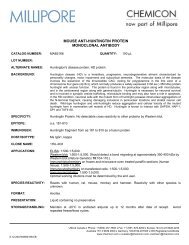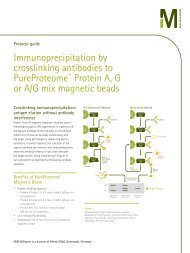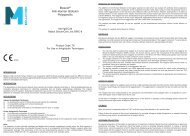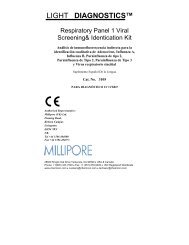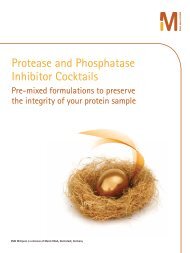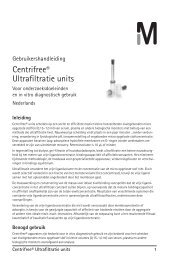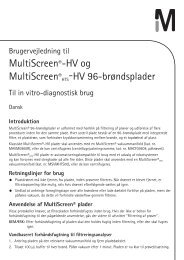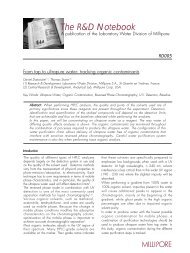Millistak+HC AppGd_textC.qxd - Millipore
Millistak+HC AppGd_textC.qxd - Millipore
Millistak+HC AppGd_textC.qxd - Millipore
Create successful ePaper yourself
Turn your PDF publications into a flip-book with our unique Google optimized e-Paper software.
Why Are Millistak+ HC<br />
Filters Better?<br />
Biological solids exhibit poor filter<br />
cake properties—very thin deposits<br />
exhibit very high flow resistance.<br />
The capacity of a clarifying depth<br />
filter is, therefore, highly dependent<br />
on the accessible internal surface<br />
area available for particle deposition.<br />
For a given media type and grade,<br />
capacity increases linearly with<br />
thickness or bed depth. Moreover,<br />
as commonly occurs in biological<br />
suspensions, the particles span a<br />
broad range of sizes—to maximize<br />
capacity, the filter media must be<br />
structured to accommodate these<br />
particle sizes in proportion to their<br />
number. For this reason, a gradient<br />
pore structure or media density<br />
is optimal.<br />
Outperforms the Competition<br />
Based on these design criteria,<br />
Millistak+ HC filters have been<br />
developed to outperform all competitive<br />
depth filters. Each cellulosic<br />
pad within the multilayer composite<br />
possesses a graded pore structure<br />
from front to back. Coupling two<br />
such pads in series expands the<br />
effective pore size range by as<br />
much as several orders of magnitude.<br />
In addition, Millistak+ HC filters<br />
employ two full-thickness cellulosic<br />
pads for an overall bed depth of more<br />
than 0.260 in.—thicker than any<br />
other cellulosic depth filter on the<br />
market today.<br />
Unique Membrane Layer<br />
Improves Performance<br />
A major advance in the design of<br />
stacked-disk prefilters, as offered in<br />
Millistak+ HC filters, is the incorporation<br />
of a microporous membrane layer,<br />
downstream of the cellulosic pads.<br />
The membrane layer delivers two<br />
important advantages. First, it serves<br />
as a final barrier to trap small particles<br />
and colloids that would otherwise<br />
foul a trailing sterile filter. Secondly,<br />
the membrane contributes a modest<br />
hydraulic resistance to the filter,<br />
which significantly improves feed<br />
flow distribution and, consequently,<br />
media utilization. All vertical stackeddisk<br />
designs inherently force a greater<br />
percentage of feed flow to the lower<br />
sections of the filter column, which<br />
are under higher hydrostatic pressure.<br />
The addition of the microporous<br />
membrane to Millistak+ HC filters<br />
helps to minimize this vertical pressure<br />
gradient, to utilize all available filter<br />
area more evenly and efficiently.<br />
Millistak+ HC Filters Application Guide 5



